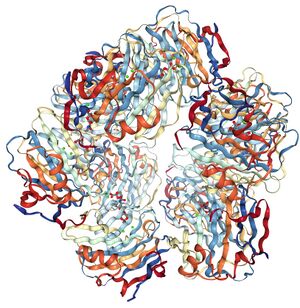Serum amyloid protein: Difference between revisions
From WikiLectures
(small change) |
mNo edit summary |
||
| Line 1: | Line 1: | ||
[[File:Schematic representation of the SAP structure..jpg|thumb|Schematic representation of the SAP structure.]] | |||
Serum amyloid protein is an acute phase reactant that is synthesized in the liver and degraded there. Its physiological function is to protect chromatin from the action of the immune system. | Serum amyloid protein is an acute phase reactant that is synthesized in the liver and degraded there. Its physiological function is to protect chromatin from the action of the immune system. | ||
Revision as of 20:24, 4 April 2022
Serum amyloid protein is an acute phase reactant that is synthesized in the liver and degraded there. Its physiological function is to protect chromatin from the action of the immune system.
It is involved in the formation of amyloid deposits, where as a coprecipitated component it constitutes 5-15% of the amyloid mass. Radiolabelled SAP can be used to determine the extent of involvement in amyloidosis.



